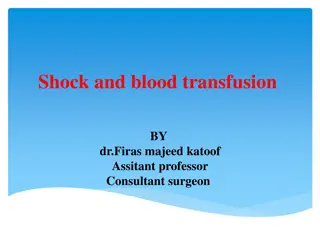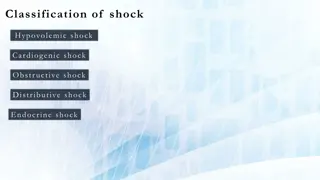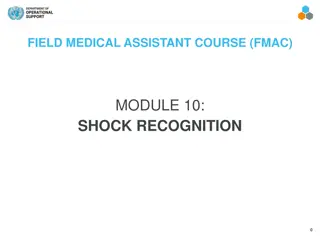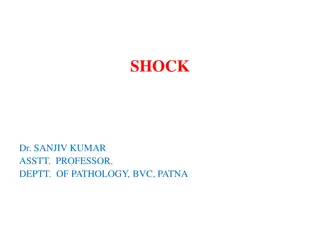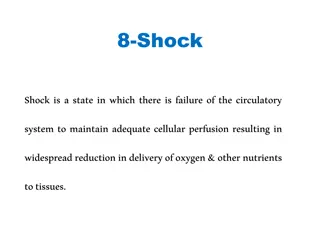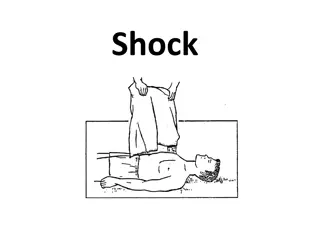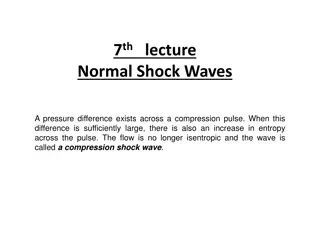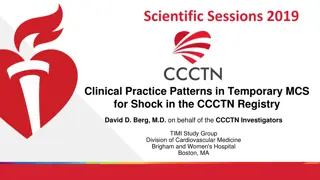
Approach to Recognizing and Managing Different Types of Shock
Learn about the recognition and management of various types of shock, including hypovolemic, cardiogenic, distributive, and obstructive shocks. Understand the causes, key assessment signs, and investigations needed to effectively address shock in emergency situations. Gain insights from Dr. Abdulaziz Alrabiah, an Emergency Medicine, Trauma & EMS specialist.
Download Presentation

Please find below an Image/Link to download the presentation.
The content on the website is provided AS IS for your information and personal use only. It may not be sold, licensed, or shared on other websites without obtaining consent from the author. If you encounter any issues during the download, it is possible that the publisher has removed the file from their server.
You are allowed to download the files provided on this website for personal or commercial use, subject to the condition that they are used lawfully. All files are the property of their respective owners.
The content on the website is provided AS IS for your information and personal use only. It may not be sold, licensed, or shared on other websites without obtaining consent from the author.
E N D
Presentation Transcript
Approach to different types of shock Dr.Abdulaziz Alrabiah, MD Emergency Medicine, Trauma & EMS specialist
Objectives types of shocks recognition management
overview definition of shock circulatory insufficiency that creates an imbalance between tissue O2 supply (Delivery) and O2 demand (consumption) result in lactic acidosis types of Shock hypovolemic Cardiogenic distributive Obstructive
Causes of shock types: 1 Hypovolamic Shock GI fluid losses e.g. gastroenteritis renal losses osmotic diuresis (e.g. DKA) adrenocortical insufficiency (partly) skin losses burns blood loss penetrating injuries ruptured ectopic pregnancy third space losses ileus from pancreatitis
Causes of shock types: 2 cardiogenic arrhythmia reduced contractility MI myocarditis cardiomyopathy poisons
Causes of shock types: 3 Obstructive Shock Pericardial tamponade tension pneumothorax massive PE
Causes of shock types: 4 Redistributive Shock septic shock neurogenic shock anaphylaxis poisoning adrenal insufficiency
Assessment of shock vital signs : may be normal ! Signs of cause hypovolaemic cold, dry skin low JVP cardiogenic cold, clammy skin elevated JVP features of LVF obstructive skin often normal markedly increased JVP redistributive warm skin JVP normal or low
Assessment of shock2 investigation ECG : ACS, arrhythmia and electrical aternans and low voltage ( cardiac tamponade ) FBE : WCC may change in sepsis, Hb doesn't increase initially in acute bleeding cultures if sepsis expected VBG : high anion gap metabolic acidosis due to high lactate coagulation profile : coagulopathy in sepsis BHCG : female ? rupture ectopic BGL : DKA / HHS Ultrasound : AAA , intraperitoneal fluid , IV measurement Echocardiography : wall motion , hypovelmia ( reduce LV function) , RV dysfunction ( indirect sign of massive PE) , cardiac tamponade chest X-ray : tension pneuthorax, pneumonia . aortic dissection,
Management of Hypovolemic shock stop fluid loss i.e. bleeding control IV fluid Normal saline / ringer lactate blood IV hydrocortisone 200 mg i.e. adrenal insufficiency may need surgery if bleeding internally
Management of Card shock IV fluid challenge treat arrhythmia treat ACS i.e. re-perfusion PTCA inotropes : Dobutamine infusion Intra - aortic ballon pump insertion ??
Management of obstructive shock tension pneumothorax needle decompression then insertion of chest drain pericardial tamponade pericardiocentesis massive PE thrombolysis i.e. tPA
Management of distributive shock anaphylaxis
Management of distributive shock Neurogenic Shock spinal cord injury i.e. trauma hypotension and bradycardia , due to loss sympathetic nervous supply treatment : IV fluid ( keep MAP > 65mmHg) inotropes : Nor-adrenaline , Doubatmine atropine for bradycardia high dose steroids ( no it is malpractice)
Management of distributive shock septic shock
Management of distributive shock septic shock treatment circulatory support IVF challenge normal saline 0.9% 20-30 ml /kg +/- blood transfusion i.e. anaemia vasopressor support i.e. noradrenaline infusion aim urine output >0.5 ml /kg/hr CVP > 8-12 MAP > 65 mmHg SCV O2 >70% antibiotics within 3 hours from presentation ceftriaxone1-2gm IV 12hr , ( kids 50mg /kg ) other : flucloxacillin, Gentamicin, Tazocin, Vancomycin infection source control




